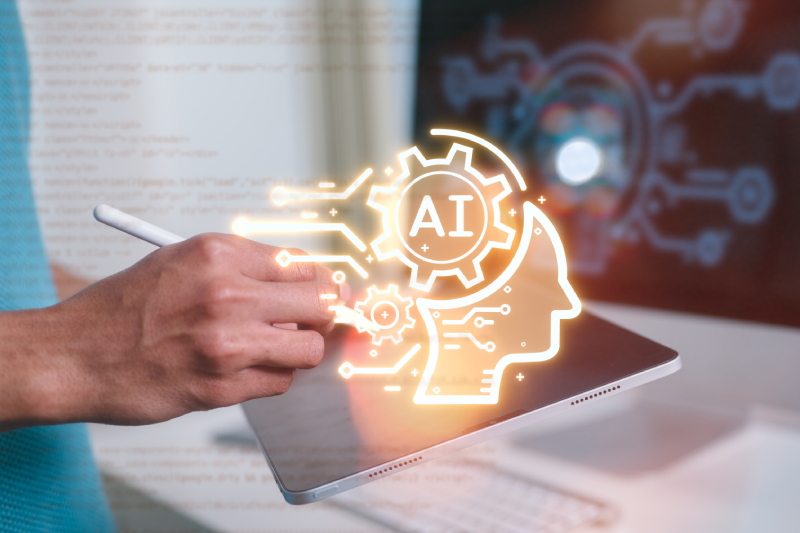AI is reshaping how we learn and educate in this age where tech meets teaching. For those who teach and manage education, AI is a big step towards more tailored, engaging, and smooth teaching and learning. AI’s knack for sifting through huge data sets, customizing learning to fit each person, and making admin tasks easier makes it a beacon of innovation in education. This piece digs into how AI is changing the education landscape, making learning more open, tailored, and effective for pupils while also boosting the teaching experience for educators. As we explore AIs’ various roles in education, it is clear that adopting these technologies is key to readying students for a swiftly changing world.
Customizing Learning Experiences with AI for the Future
Now, educators and those who run schools are using AI to move from a broad-brush teaching approach to customized learning paths. AI examines how learners act, their performance, and likes, adjusting the pace, complexity, and learning methods to fit each one. This customization boosts engagement and marks, with AI-driven platforms tuning to a pupil level. The perks of such tailored learning paths include better grasp and memory, as AI spots learning gaps and offers focused aid. As AI keeps honing these personalized learning journeys, education simplifies educational work and makes administrative tasks smoother.
Streamlining Administrative Tasks in Education with AI
AI transforms education admin in big ways, easing educators’ burdens. Tasks it takes over include
- Using smart algorithms for grading, ensuring accuracy and evenness.
- Handling student records and academic histories with precise data entry, keeping info current and error-free.
- Making progress reports smoother, letting educators focus more on lesson plans and direct student talks.
With AI handling these jobs, educators can concentrate on their central role in inspiring and educating students. This shift towards more direct and tailored teaching is crucial for readying students for future challenges, ensuring they get the needed support and focus to excel.
AIs Role in Enhancing Accessibility and Engagement
AI is revolutionizing how accessible and engaging learning is for all students, including those with disabilities. Adaptive tech, powered by AI, plays a big part in aiding students with various needs, such as
- Voice-to-text features are available for those with visual challenges or reading issues.
- Speech-to-text tools for students with physical hurdles make it easier to participate in writing tasks.
- Using predictive analysis to keep content engaging, customizing it to hold learners’ interest.
Furthermore, AI keeps students hooked by tailoring educational content and methods.
Using AI for Data-Driven Curriculum Development
In the education evolving scene, bringing AI into curriculum building starts a new chapter of personalized and dynamic learning.
The gains of using AI for curriculum building spread beyond just tailored learning, including
- Making reading tasks or tests that align with each learner’s progress and needs.
- Keeping lessons up to date with the latest studies and market needs.
- Adding interactive simulations and real-time quizzes, catering to various learning styles.
As education folks embrace AI’s potential in curriculum making, it is clear that AI’s role in education goes beyond making administrative tasks easier and customizing learning.

AI as an Educational Assistant in Modern Learning
In today’s fast-moving educational landscape, AI is reshaping educators’ roles by taking over routine duties such as grading and administrative work. This change lets teachers focus more on their core mission of educating, guiding, and motivating students. AI tools, including auto grading systems, not only speed up evaluation but also give immediate feedback to students, pinpointing areas needing more work.
Studies show that AI in teaching can cut educators’ admin tasks by up to thirty percent. This big drop in admin work lets teachers spend more time on direct student interaction and lesson prep, lifting education quality. AI’s benefits stretch beyond saving time. It aids teachers in providing a more personalized learning journey. By automating grading, educators can spot where students struggle and adjust their teaching accordingly.
Read More : Unlocking Opportunities: An Introductory Guide to Funding Your Social Venture
Advancements in AI Powered Learning Analytics
The growth of AI-powered learning analytics is transforming education, giving educators and school heads unparalleled views on student progress, absence, and behavior. By deeply analyzing loads of data, AI now offers detailed feedback on student involvement, predicts performance, and spots learners needing extra help or steps. This new data analysis approach boosts students’ educational journeys and lets educators fine-tune their teaching strategies.
Learning analytics, powered by AI, is key in today’s education system. It gathers, analyzes, and reports data about learners and their settings to understand and improve learning and its environments. With AI, educators can foresee which students might fall behind or drop out, stepping in early to offer needed support. This foresight is key in customizing learning to each student’s needs, ensuring no one is overlooked.
Embracing AI in Education: A Path to Enhanced Learning and Teaching
Walking through AI integration into education shows its vast benefits for both students and educators. From crafting personalized learning tracks to easing teachers’ admin work, AI is reshaping teaching and learning methods and making education more inclusive, engaging, and fit for today’s needs. By harnessing AI’s powers, educators can enrich their teaching methods, and institutions can offer a learning journey that readies students for tomorrow’s complexities. Adopting AI will undeniably be key in pushing learning forward as education keeps evolving.








